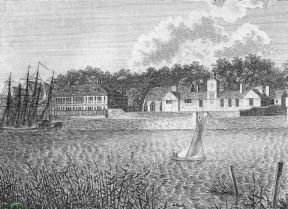The Greenwich Meridian
…where east meets west
| Location | England LB Greenwich Greenwich (SE10) |
| Crowley House (site now occupied by Greenwich Power Station) | |
| Distance (N) from Greenwich | |
| OS map details | OS Explorer: 161 or 162 |
| OS grid ref | TQ 38854.78175 (538854,178175) |
| WGS84 lat/long | 51.485488, -0.001585 |
| Type | Astronomical |
| Marking date | 1762 (or earlier) |
| Access | None, but site visible form Highbridge Wharf. Mark no longer present |
Currently viewing images from 1796
 |  |
Click to choose image set
Ground based marks accurately placed on the meridian were regularly used by the Greenwich astronomers as a quick means of determining the alignment errors of their transit instruments. When both a northern and a southern mark were available, they allowed errors in both the direction in which the telescope was pointing and the alignment of the optics within the tube (errors in collimation) to be detected.
When Halley’s 5-foot Transit Instrument was retired by Bradley in 1750, it was replaced with an 8-foot Transit Instrument by John Bird in a new building about 120 feet to the east. In continuous use until 1816, it was used with a variety of meridian marks to both the north and the south. None survive. In the preface to his first volume of Greenwich Observations (published in 1776), Maskelyne describes the marks as he found them when he arrived at the Observatory in 1765, along with his subsequent alterations.
… I found also a meridian mark placed on a house to the north, with a hole in it, thro’ which the river was seen; but this not appearing always sufficiently bright, I placed an iron plate painted white immediately behind the hole, which has generally appeared a more distinct object seen through the hole, than the sky seen through the holes in the southern marks.
The house in Greenwich to which the north mark was attached can only have been Crowley House; a substantial building that stood immediately to the east of Trinity Hospital on the banks of the Thames. Its construction began in 1647 and in 1704 it was sold it to the Newcastle ironfounder, Sir Ambrose Crowley. Owned by the Millington family from 1805, the House was demolished in 1854. Its site is now occupied by Greenwich power station. Crowley House is the building fronting the river on the extreme right in the c.1675 image set and on the left in the 1796 view. The two undated views are both miscaptioned and were published in Victorian times.
When Bradley first started using a north mark is not known. Nor is there any description of it in his published observations. The first (and only) mention he makes of it in the published observations, does not come until 1 January 1762. Up to this point, he only ever refers to ‘the Mark’ or the ‘South Mark’ (or a mark identifiable as such from its description). It is not impossible that the north mark was set up long before 1762, the specific reference to the ‘South Mark on Lord Chesterfield’s House’ in June 1751 could for example be taken to imply the existence of a north mark at that time.
Having to negotiate access to the marks and never having them under one’s full control would not only have been inconvenient, but could also lead to unwitting errors. The truth of this was brought home to Maskelyne in November 1768, when he discovered a collimation error of around 30” of arc on reversing the telescope during an observation of Polaris. By comparing the recorded transits of the high and the low stars prior to this time, he was able to establish that the collimation problem originally arose in late August. Reporting the whole episode in the published observations, Maskelyne observed: ‘This error might have been discovered sooner if the North Mark had not been lately removed, on repairing the House on which it was fixed.’ Maskelyne then added: ‘This Mark was later replaced’. This is the only time in all the published observations that Maskelyne refers to the North Mark or even implies its existence. References to collimation checks are few and far between occurring when they do, mainly in the summer months when the days are longer. Maskelyne records two later occasions when large collimation errors (in excess of 7” of arc) occurred. The first, he concluded had arisen on 21 July 1795 and was picked up a week later on 28 July. The second occurred later that year on 25 November, but remained undetected until 29 May 1797. For the error to have remained undetected for so long, suggests both that, Maskelyne no longer had a North Mark at this time, and that he had not learned the lesson from 1768 either by developing a methodology for reducing and analysing his observations more quickly.
Image: Bradley’s 8-foot Transit Telescope




